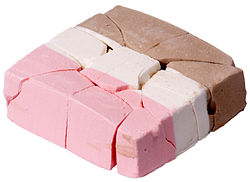Freeze-dried ice cream

Freeze-dried Neapolitan ice cream
|
|
| Type | Ice cream |
|---|---|
| Created by | Whirlpool Corporation |
| |
|
Freeze-dried ice cream is ice cream that has had most of the water removed from it by a freeze-drying process, sealed in a pouch, and requires no refrigeration.
It is also known as astronaut ice cream or space ice cream, typically a slab of ready-to-eat dehydrated ice cream. Compared to regular ice cream, it can be kept at room temperature without melting and is more brittle and rigid but still soft when bitten into. It was developed by Whirlpool Corporation under contract to NASA for the Apollo missions. However, it was never used on any Apollo mission. Freeze-dried foods were developed so that foods could be sent on long-duration spaceflights, as to the Moon, and to reduce the weight of the water and oxygen normally found in food.
Freeze drying (or lyophilization) removes water from the ice cream by lowering the air pressure to a point where ice sublimates from a solid to a gas. The ice cream is placed in a vacuum chamber and frozen until the water crystallizes. The air pressure is lowered, creating a partial vacuum, forcing air out of the chamber; next heat is applied, sublimating the ice; finally a freezing coil traps the vaporized water. This process continues for hours, resulting in a freeze-dried ice cream slice.
Freeze-dried ice cream is sold by mail order and is common in science museums and NASA visitor center gift shops, sometimes accompanied by other freeze-dried foods.
Despite the modern images of space walking astronauts in shuttle era space suits, freeze dried ice cream was not included on any Apollo, Skylab, Space Shuttle, or International Space Station missions. According to one NASA food scientist, although freeze-dried ice cream was developed on request, "it wasn't that popular."
...
Wikipedia
